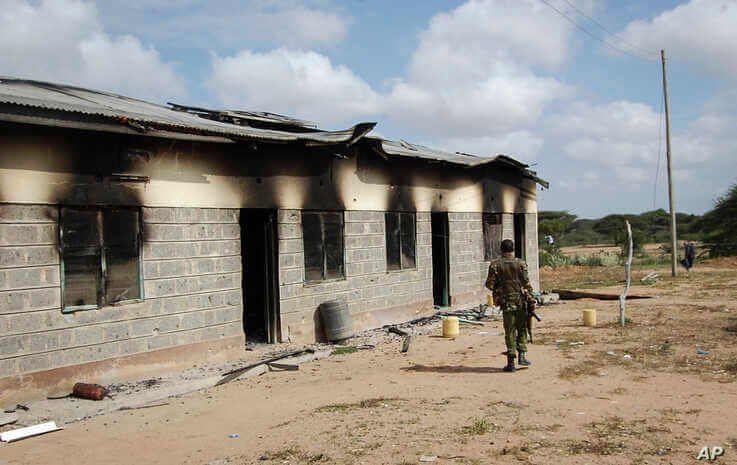
US Warns Containment the Only Option for Some African Terror Groups
U.S. defense and intelligence officials are voicing renewed concerns about the spread of increasingly capable terror groups in Africa, warning some have become so powerful it is no longer possible to “degrade” them.
The warnings, part of a newly released report by the Defense Department’s inspector general, echo earlier warnings by the U.S. military’s Africa Command about growing threats to the U.S. homeland.
They also come as the Pentagon unveiled a proposed $740.5 billion budget for next year focused not on terrorism but on competition against China and Russia.
"The terrorist threat in Africa remains persistent, and in many places, is growing,” according to Defense Department lead inspector Gen. Glenn Fine, pointing to the latest intelligence assessments of the various African affiliates of al-Qaida and Islamic State, also known as IS or ISIS.

“The threat posed by al-Shabab and ISIS-Somalia in East Africa remains 'high,' despite continued U.S. airstrikes and training of Somali security forces,” Fine wrote in the report, based on information from U.S. Africa Command (AFRICOM) and the Defense Intelligence Agency (DIA).
In West Africa, the report concludes the terrorism landscape is just as concerning.
U.S. Africa Command “has shifted its strategy from ‘degrading’ these VEOs (violent extremist organizations) to ‘containing’ them,” the report states.
The report also quotes U.S. Africa Command as saying the various terror groups in West Africa “have the potential to spread through the region and impact Western interests.”
Tuesday’s report on U.S. counterterror operations in Africa is the first from the inspector general to be released to the public — previous versions were classified.
But public concern about the escalating dangers presented by terror groups in Africa dates back to at least November, when the United States hosted a meeting of the global coalition to defeat IS.
"We agreed at the working level that West Africa and the Sahel would be a preferred, initial area of focus for the coalition outside of the ISIS core space and with good reason,” Secretary of State Mike Pompeo said at the time on Twitter. "ISIS is outpacing the ability of regional governments and int'l partners to address the threat.”
Senior U.S. Africa Command officials began raising concerns at about the same time, describing both IS’s African affiliates and al-Shabab as threats “to U.S. interests in East Africa, as well as to the U.S. homeland.”
More recently, following the January 5 al-Shabab attack on the Manda Bay Airfield in Kenya which killed three Americans, those concerns have risen to new heights.

Gen. Stephen Townsend, commander of U.S. forces in Africa, told lawmakers outright that, “some of those groups threaten the American homeland today."
Just this week, the State Department and the FBI announced the launch of a new joint terrorism task force with Kenya, the first located outside of the U.S., to push back specifically against al-Shabab.

Yet despite fears about the expanding reach of Africa’s terror groups, Pentagon officials have been focused on plans to reduce the U.S. military footprint in Africa by perhaps 10% over the next several years — efforts U.S. Defense Secretary Mark Esper has described as a “rebalancing” or a “right-sizing.”
Esper, speaking to reporters on route to Brussels Tuesday for meetings with NATO allies, said what happens next with counterterror operations in Africa would be a topic of conversation.
"Our European partners, there is room for them to step up in Africa and to do more,” he said, adding that he has yet to make any decision about U.S. posture on the continent.
Only European and Western security officials, while very much concerned about the growing capacity of terror groups in Africa, say they are not convinced of their ability to strike Western targets on Western soil.
"In the short term, the Sahel region and the Horn of Africa are unlikely to replace the Middle East and Afghanistan as regions from which the main threat to Europe emanates," one European Union security official told VOA.
Some U.S. officials are also less forceful than U.S. Africa Command in describing the threat.
According to the inspector general report, the U.S. Defense Intelligence Agency assessed that al-Qaida-linked al-Shabab poses only “a low threat to the U.S. homeland."
Still, the DIA and Africa Command see the bigger picture as worrisome, with terror groups establishing more active and intertwined networks, funneling each other cash and fighters while sharing expertise.
Sometimes, the networks are willing to cross ideological lines, with al-Qaida and IS operatives willing to cooperate and help each other — something that would have been unimaginable based on the animosity between the groups in the Middle East and elsewhere.
The groups are also getting stronger.

U.S. intelligence officials believe al-Shabab in Somalia is now raising $10 to $20 million a year through taxation, while boasting anywhere from 5,000 to 10,000 fighters.
Al-Shabab has also been pumping out more social media propaganda, though military officials question just how effective it has been.
IS-Somalia, while much smaller with just 100 to 300 fighters, has been resilient, and like al-Shabab, seemingly unhindered by U.S. airstrikes that kill just one or two fighters at a time.
The limited impact of direct U.S. military strikes is sparing bigger concerns about the Pentagon’s focus on shifting troops from Africa.
"Many partner forces in Africa will likely require assistance and advising for a long period of time before they can fully address VEO threats on their own,” the report states. “This need for ongoing operations, coupled with the often slow development of partner forces, could require ongoing commitment of U.S. military resources.”
 US Attorney General Blasts ‘Rogue’ Prosecutors Amid War on Sanctuary CitiesNext PostPolls Closing in New Hampshire, the First 2020 Democratic Presidential Primary
US Attorney General Blasts ‘Rogue’ Prosecutors Amid War on Sanctuary CitiesNext PostPolls Closing in New Hampshire, the First 2020 Democratic Presidential Primary






